Public attention is the oxygen of pro cycling teams, but in Denain at the start of Paris-Roubaix Femmes avec Zwift, the Zaaf team parked its team cars late, well away from the bustle of the rest of the paddock, almost as if trying to keep the lowest profile possible.
No luck. Instead, press cameras clicked away, capturing the scene as Audrey Cordon-Ragot tearfully embraced her former Zaaf teammate Maggie Coles-Lyster. Their emotional meeting – just two days after Cordon-Ragot switched teams to Human Powered Health – was not simply two national champions and former teammates paying mutual respect.
The subtext, understood by all, was the tension around Zaaf, which for weeks had been said to be in trouble, and wasn’t paying its riders. Cordon-Ragot’s departure was an unmistakable sign that the situation wasn’t improving.
In truth, the Zaaf team went backward almost from the start.
At January’s Tour Down Under, the opening race on the Women’s WorldTour calendar and the team’s first event, Zaaf riders received only two team kits, and one bike each, which the Australia-based riders got only the day before the start. Team staff was so green that the mechanic had never worked in a bike race. Riders also noted what they felt were sexist comments from staffers. Senior staff was controlling, insisting that riders not leave the team hotel in Adelaide without a staffer, for their own safety, they were told. The team didn’t have credit cards yet, leaving riders to sometimes cover expenses.

Most of that – except the crude and controlling behavior – could be forgiven as the hiccups of a freshly minted Continental team in its first race, thousands of miles from home (the bikes had been held up in Spanish customs, for instance). But the experience left riders with the unshakable sense that, as one said, “It was a women’s team that didn’t really feel like it had respect for women.” The problems accelerated from there.
At February’s UAE Tour, a similarly short-staffed Zaaf hired two local women to give massages. But they lacked any experience in bike racing and were incapable of other soigneur roles like roadside feeds. As temperatures on stages passed 30 ºC (86 ºF), the team had only one bottle hand-up in the feed zone.
There were acute equipment shortages, particularly of bikes. “We had to complain to get [clothing] that was needed for winter in Europe,” said one. “And the answer [we got] was that you should be happy if you receive even one ‘Gabba’ [rain jersey]; this was normal equipment that’s in the contract.”
The team tightly managed travel to races within Europe, sometimes insisting on long overland transfers rather than short flights, which riders weren’t allowed to book even at their own cost. Some drives were done overnight, without hotel stops, and driven by staff members who nodded off behind the wheel.
And as the weeks and then months went by, the riders watched their bank accounts dwindle as promised salary payments never came. Exasperated, several riders finally contacted The Cyclists’ Alliance (TCA), the unofficial union for female pro cyclists, and in late March the Union Cycliste Internationale (UCI) acknowledged it had received reports of nonpayment and was investigating.
By early April, the hairline cracks in the team’s facade spread as Cordon-Ragot, one of the team’s star riders, received permission from the UCI to sever her contract. A little over a week later, the fissures split open wide when the UCI released six more riders from their contracts.
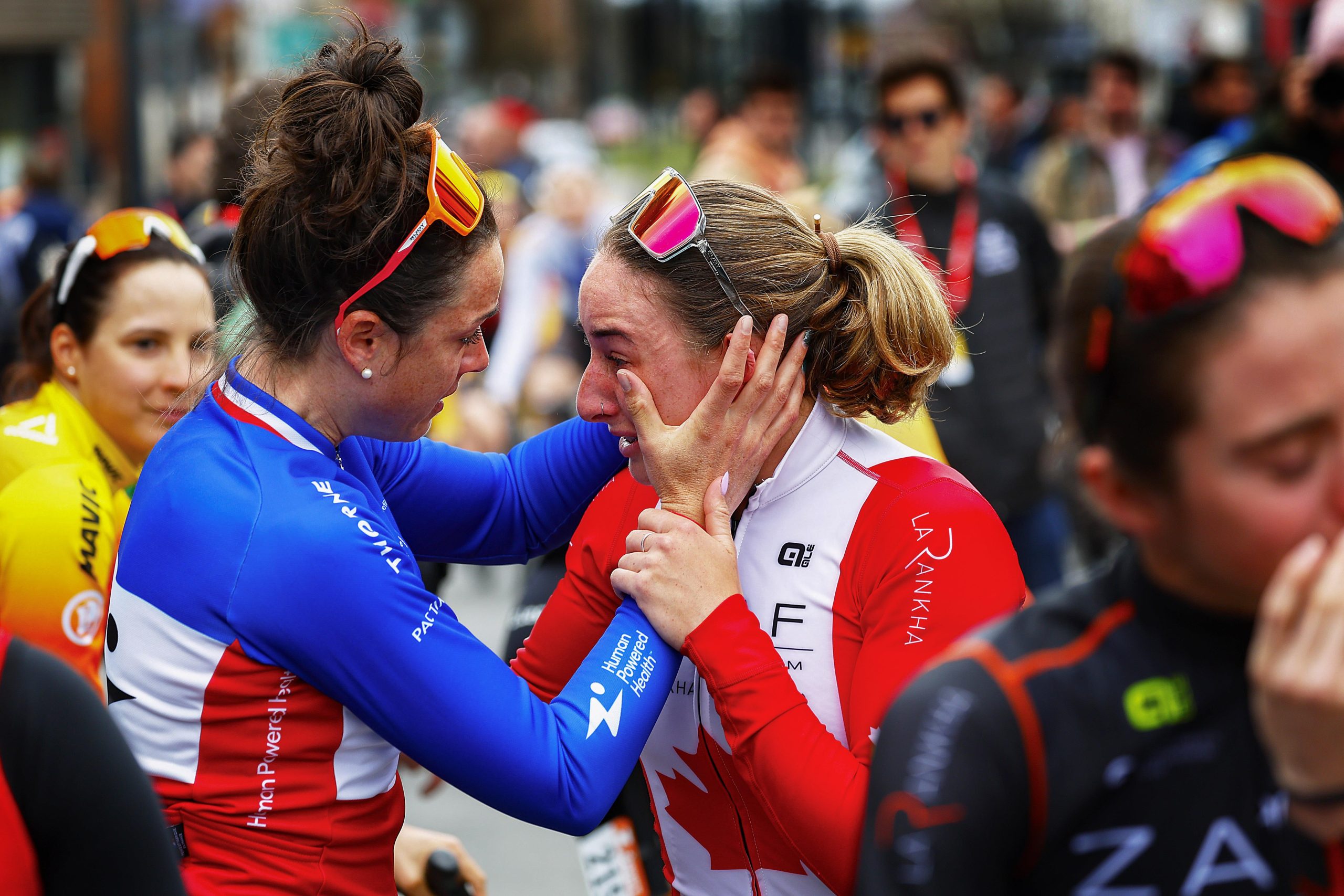
Zaaf is now down to eight riders, the minimum for a UCI women’s Continental team. Already, the team’s troubles have cost it an invitation to the Tour de France Femmes avec Zwift, with race director Marion Rousse telling l’Equipe that “we couldn’t condone having a team at the start that didn’t pay its girls.” Barring a miraculous turnaround, Zaaf may see its license provisionally suspended in the coming weeks, or even cease to exist.
This account of the team’s stunning collapse is based on interviews with 10 sources, including multiple riders and team insiders, as well as financial documents and team communications obtained by Escape Collective. Those affiliated with the team requested anonymity to speak freely, citing instances of intimidation and retaliation by team ownership, and because they are still owed substantial amounts of money.
The story they told is that Zaaf, in all likelihood, is going to fail. But that will not be the first time it has met such an end, and the key question is not only what caused the 2023 team’s troubles, but why it was awarded a UCI license in the first place – and what that means for preventing future Zaafs.
The power – and problems – of Zaaf
There are 60 UCI women’s Continental teams, ranging from tiny developmental outfits to more established ones like Parkhotel Valkenburg and Ceratizit-WNT that operate at closer to a WorldTour level. In that scrum, Zaaf cut a high profile for a brand-new team.
The name, Zaaf, is not a sponsor, but a nod to history: Abdel Kader Zaaf, an Algerian who was one of the pioneering African riders at the Tour de France, which he first raced in 1948. Riad Belatreche, the team owner, is his grandson. Belatreche’s personal background in the sport is obscure, consisting mostly of rumors of a one-time role with the Tour d’Algerie and supposed connections with the UCI. It’s the historical, family link to the sport that the team leans on heavily: Belatreche’s way to honor his ancestor’s legacy. “He wanted this team to show the world who his grandpa is, the power of Zaaf,” said one rider of Belatreche’s motivation.
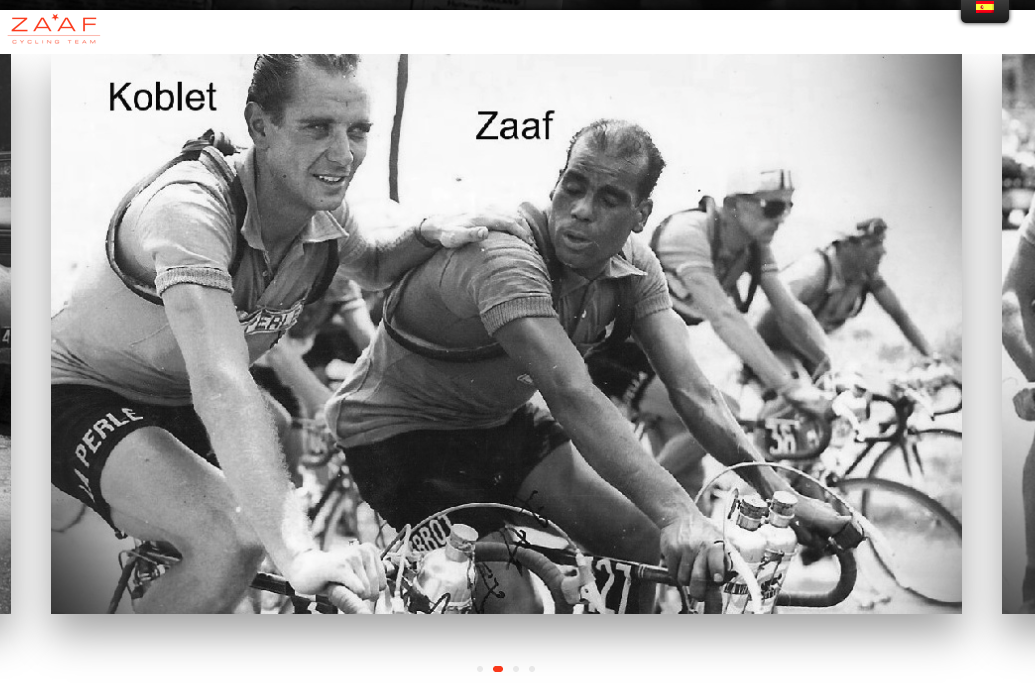
Belatreche and his senior staff, namely lead director Manel Lacambra, talked a good game: a near WorldTour-level budget of €4 million, for five years. The team would compete in all the major races, and give riders top-class support. The roster certainly supported the team’s ambitions.
Whether by design or luck, Zaaf capitalized on the failure of the ill-fated B&B Hotels project. When B&B Hotels collapsed in December after it couldn’t secure funding, it left a number of women in need of a team just weeks before the start of the season. Zaaf swooped in and signed many, including national champions Cordon-Ragot and Coles-Lyster, instantly upgrading the team’s talent level. “It was kind of the saving grace for the riders who had been on B&B,” one rider said, adding that the team budget was an attractive selling point. “The amount of money they had to play with was big.”
And the race invites did follow, said riders. “The one thing they pulled through on was the calendar,” noted one with grudging admiration. The team got starts at early-season WorldTour stage races like TDU and UAE; prestigious one-day events like Ronde van Drenthe and Trofeo Alfredo Binda; even the coveted cobbled Monuments, the Tour of Flanders and Paris-Roubaix.
The riders held up their end of the bargain. Danielle de Francesco notched two top-five finishes at TDU, and Cordon-Ragot – who had a major health scare last September from a stroke and was even told she might not race again – returned to form with several podium finishes, plus fourth-place results at Le Samyn and the Tour de Normandie Féminin. But the race calendar ended up being about the only promise that panned out.
At the UAE Tour, officials showed riders pictures of a full-size bus they said would be the team’s nerve center at races, and Belatreche talked of the expensive private jet he would buy to fly the team in style. Neither happened.
The team also had several marquee bike-industry sponsors like Enve and Wahoo, but equipment was often scarce. Riders were promised a race bike, a spare, a home training bike, and a time-trial bike. In several shipments from January through mid-March, Enve provided enough of its Melee road modules (frame, fork, handlebar, stem, and seatpost) to outfit the team more than twice over, and dozens of wheelsets, but many team bikes were never built; groupsets for them hadn’t been procured. Riders used the same bike for training and racing, and had to provide their own pedals, because those hadn’t been paid for either. At races, there were often just two spare bikes for the entire team.

Support was erratic, from a rotating cast of characters – often friends of Lacambra’s or the Belatreche family – with little or no background in cycling. There was a camper driver named Antonio, an older friend of Belatreche’s who had trouble following even basic GPS directions and, one rider told me, was caught by hotel staff one morning stealing food from the breakfast buffet. There were mechanics who couldn’t properly inflate tires, forcing riders to go to other teams for even basic help. At Paris-Roubaix Femmes, riders flatted only to discover that there was no sealant in their tubeless tires.
The team president, Riad’s 21-year-old daughter Sheima, was upbeat in e-mail communications to the team but had no experience in the sport and complained of being stressed out by her responsibilities. Although Continental teams are required to have health insurance policies, one rider learned the team’s coverage might not fully cover crash injuries and wasn’t even active for the team’s first month of competition.
While Riad owned the team and Sheima ostensibly ran operations, the team’s face and main staff presence at races was Lacambra, a longtime director who had previously worked for Cylance, Bigla, and Cervelo Test Team. Lacambra did not respond to two e-mailed requests for comment for this story, including a list of questions, but riders portrayed him as enthusiastic and optimistic about Zaaf. “He believed in [the team],” said one rider. “He still believes in it; that’s the craziest part.”
But riders also told me he had “old-fashioned” views of women and a reputation for belittling comments about riders’ bodies, or about other women in front of the riders. Lacambra often refused to tell riders their race schedules in advance, which affected their ability to create proper training plans.
He was also brash to the point of dangerous; on at least two occasions, I was told, Lacambra drove public roads at speeds of up to 200 kph (125 mph) with team members in the vehicle, and refused to slow down even after being told his behavior was frightening.
At the Tour of Flanders, he was attempting to bring a crashed Zaaf rider back to a group when he broke longstanding race rules by driving up the Koppenberg; not in 35 years – since Jesper Skibby was infamously run over there by a race director’s car – have team support vehicles been allowed on the narrow climb. The rider was DQ’d.
At a hastily organized team camp in mid-February, after weeks of red flags, riders called a meeting with Lacambra. There was a long list of questions, and while Lacambra had been irritable in the hours before the meeting, he gamely tried to soothe their concerns. Yes, of course they would get all the bikes they were promised; time trial bikes too (where these would come from was unclear; Enve does not make a time-trial frameset). Yes, riders would travel to races at least two days before to allow for course recon. And obviously, yes, the riders would be paid soon.
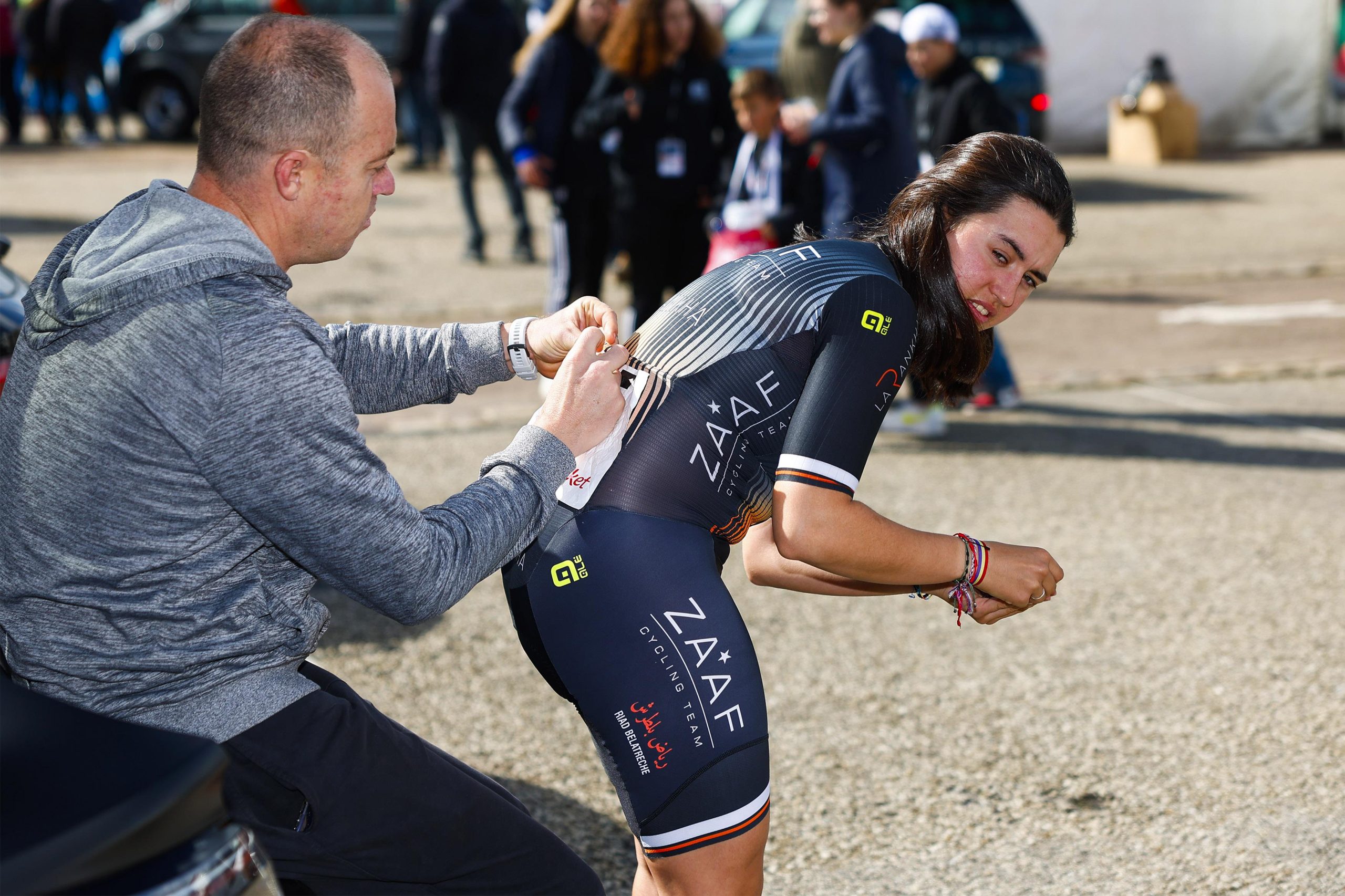
Riders voiced some sympathy for Lacambra’s position; after all, he didn’t control the finances. But they also weren’t satisfied by his answers, which ultimately proved to be just more unmet promises.
Money mysteries
The standard UCI rider contract says that salaries are to be paid between the first and fifth of the month, for the prior month’s work. By February 6, no payments for January had appeared, but Sheima Belatreche sent a warmly worded email to team members outlining how salaries would be paid.
“I want to inform you that you will soon receive the payroll of the following three months in advance, by means of a transfer from a bank in Dubai, since it is the headquarters of the company that our father has established and that will be one of the most important of the holding of family companies,” it read in part. She closed the email with the phrase “A warm hug.”
But the payments still didn’t come, and a shifting series of explanations followed about why: that the owners were in the process of opening accounts in Europe, or that transfers had been delayed by regulatory red tape. “People didn’t have enough money to buy groceries,” said one rider of how desperate the situation became. “The wife of the owner was sending petty cash to people, and we were like, ‘Why can they send a couple hundred Euros, but they can’t send salary? What’s the difference’?”
The little money that did come arrived via strange provenance. Before mid-April, according to Jean-François “Jeff” Reymond, director of The Cyclists’ Alliance, the only rider who got even part of her salary was paid from a property-management firm in Dubai that is not the team’s registered agent. Petty cash and reimbursements, when they happened, came directly from Belatreche family members, or other companies altogether. None came from the team itself.
Sheima’s email referenced Dubai as the company’s headquarters, and there are at least two Belatreche-linked entities licensed there, both operating in the oil and gas business. Further details aren’t available except to identify Riad Belatreche as the primary contact. But neither is officially connected to Zaaf.
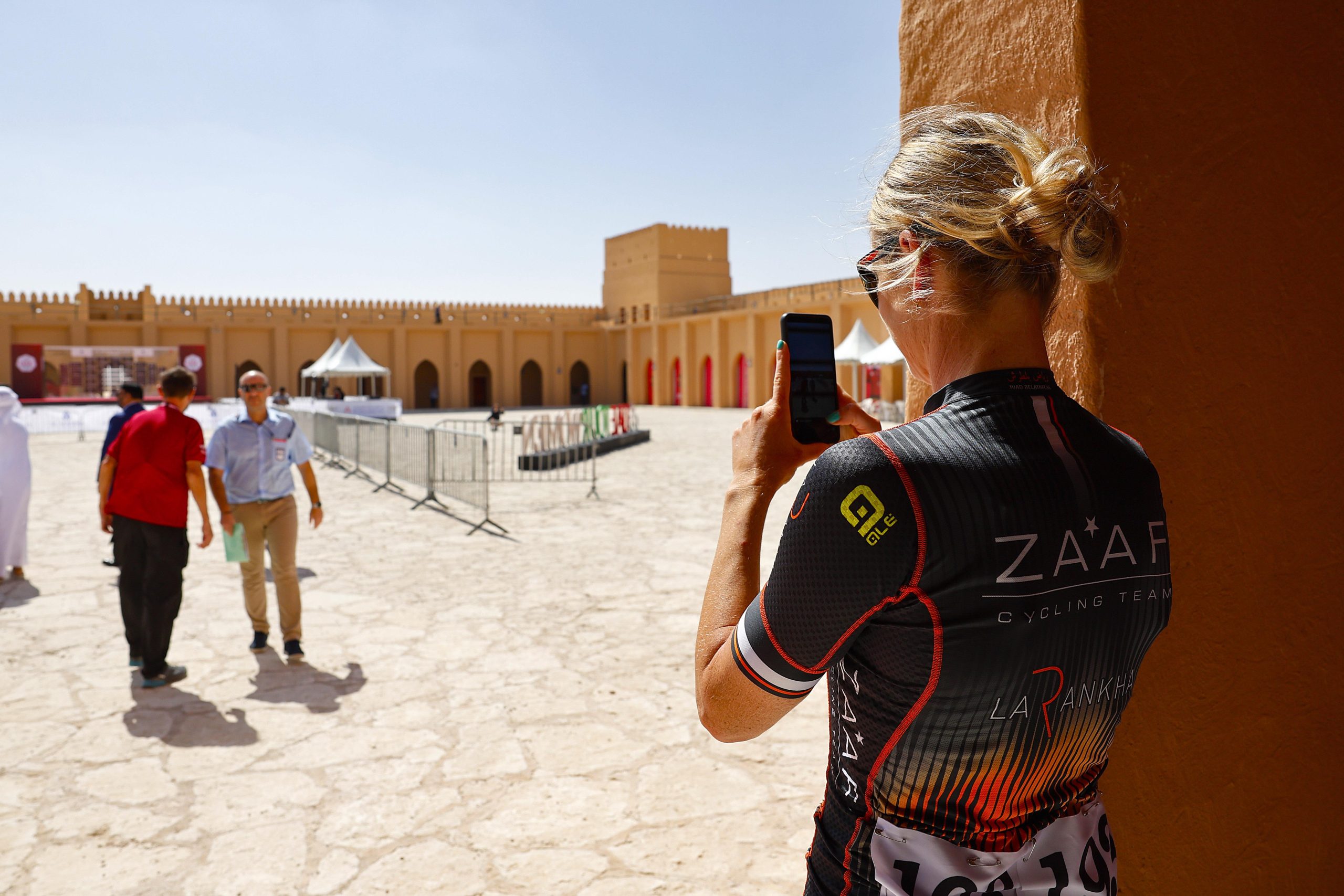
The team’s registered agent is a Belatreche-owned firm in Spain which, according to public registry documents there, was incorporated in December 2021 as Zaaf Global Cycling before changing its name in March 2022 to LaRankha Trade SA, at which time it also changed its business category to the wholesale oil and gas trade. (The LaRankha logo appears on team kit.)
Riad and Sheima are listed, respectively, as secretary and president at LaRankha Trade SA (according to her LinkedIn, Sheima’s other primary work experience was part-time at Dunkin’ Coffee). The company’s most recent annual account filings, made in March 2022 around the time of the name change, cover only through the 2021 fiscal year. As of that filing, LaRankha Trade SA had no employees and just €60,000 of total available assets.
All of that money comes from a related Spanish company called EURL Promotion LaRankha, also directed by Riad Belatreche, and which is nominally in the wholesale oil and gas business, but also deals in the acquisition of shares and interests in other commercial companies. In 2020, according to its account filing, Promotion LaRankha had no employees and total business activity of just €3,182.54; perhaps understandable, since it was incorporated only on November 10.
But 2021 was a big year at Promotion LaRankha: a hiring spree boosted the employee count to one, who managed to oversee an influx of €46 million in total business activity. The vast majority – €43,541,832.62 – is listed as non-current assets. A note deep in the filing shows the source of the sudden windfall: a non-monetary “liquid and enforceable credit right” in the form of 43 million shares, nominally valued at one Euro each, in another EURL Promotion LaRankha corporation, this one based in Algeria and, according to the Spanish filings, a real estate development company.
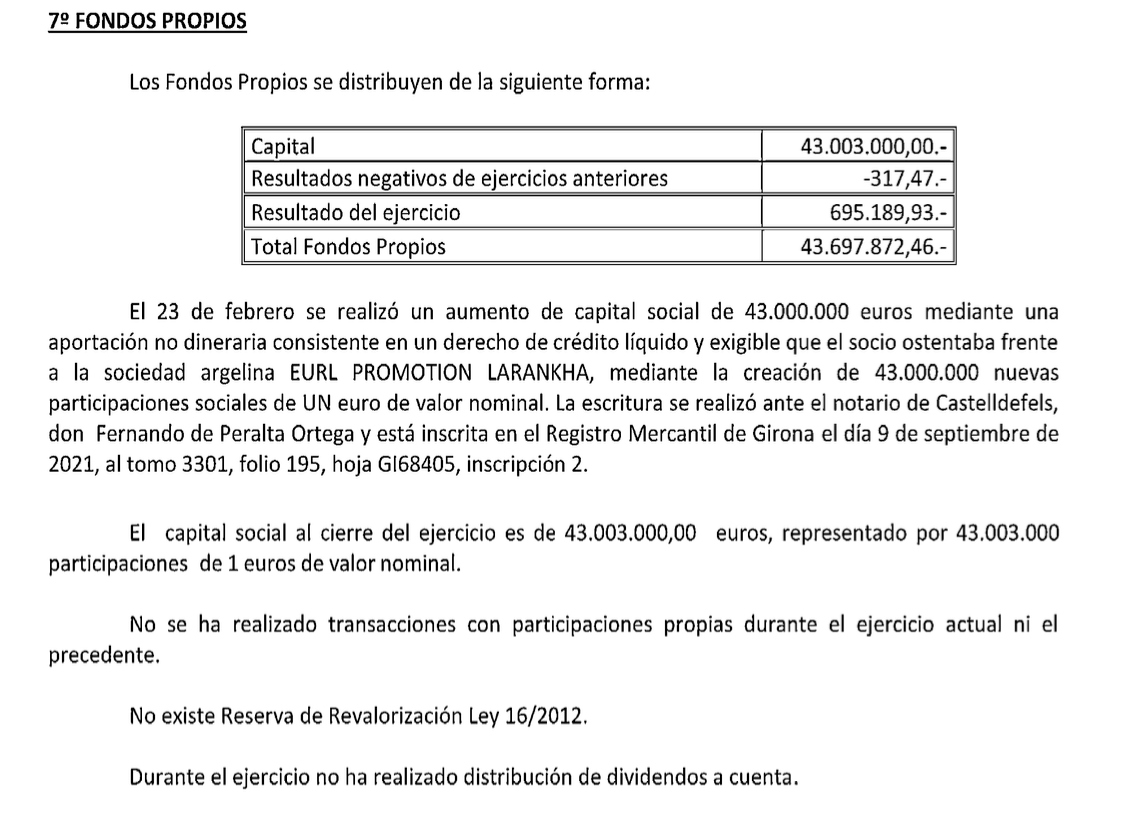
The Spanish LaRankha Promotion reported just under €3 million in revenue in 2021. Not bad for one full-time employee. But also not enough to sustain a €4 million team budget. And nominal value is, essentially, the amount that a company claims an asset is worth, not its market value. Since Algeria doesn’t have an accessible public business registry, it’s impossible to know the basis for that valuation, or LaRankha Promotion Algeria’s financial state.
Several other Spanish corporations with Belatreche family members listed as officers, like Botal, Renji, and Narisheifa Construction, similarly report no employees and total economic activity in the €3,000 range each, with the latest filings covering only through 2021; no accounts for 2022 have yet been filed.
In addition to the erratic cash flow and near-total lack of employees, none of various LaRankhas, nor the other Spanish companies, has any public presence: no websites, no social media, and no coverage in business media. The Barcelona address listed for both Spanish LaRankha companies is, riders told me, a Belatreche family apartment.
Sources told me that the family appears to live a wealthy lifestyle. There are apartments in expensive neighborhoods in Barcelona; Sheima reportedly talked of travel to Dubai and Miami, among other locations.
Sources said Belatreche liked to talk about material luxuries like clothing, shoes, and cars; a Pinterest account that appears to be his is filled with images of luxury automobiles like Maybachs and Aston Martins, although not necessarily his (he appears to have a particular fondness for sporty convertibles). In a smiling selfie on his LinkedIn, Belatreche appears alongside someone who appears to be Josep Maria Bartomeu, the former president of FC Barcelona, although what, if any, relationship they have is unclear.
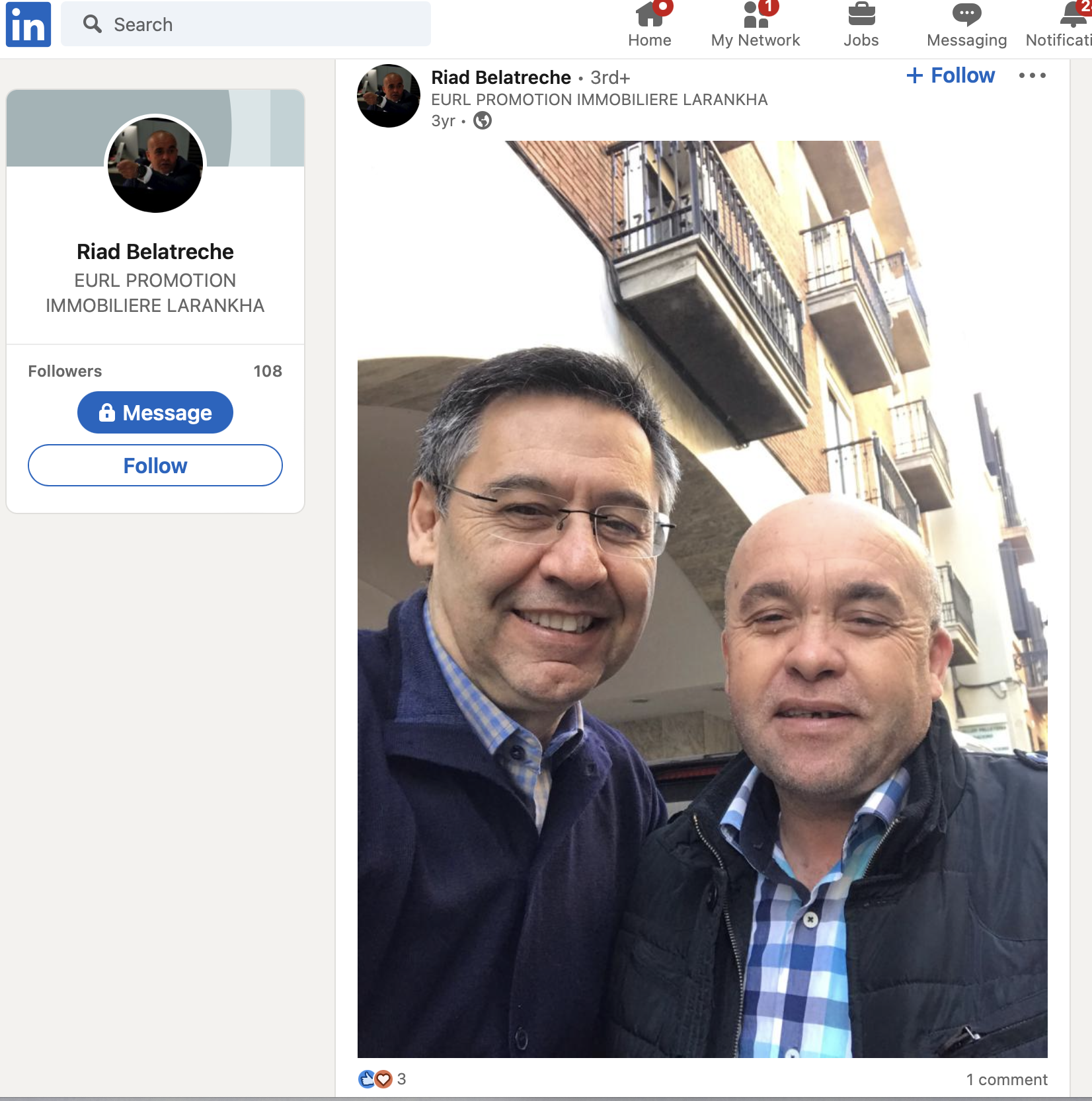
But there are few concrete hints of business activity. Aside from the odd selfie, Belatreche’s spartan LinkedIn account consists mostly of a few likes and one-word comments on other posts, sometimes about energy projects. Only once has he interacted with a post that involves cycling.
The traces are faint, mostly the web of corporations in Spain, Dubai, and Algeria, and whispers that Belatreche does indeed have ties to the Algerian oil and gas industry. But no one I spoke with seemed certain of the source of the family’s money. And it’s even less clear why they’re not making good on their contractual obligations like salary payments.
Anyone who’s been poor knows that financial stress manifests in myriad ways. As the pressure of unpaid bills and team dysfunctions mounted, one rider said she had what she can only describe as a stress breakdown on the side of the road after one race. “I was like, ‘Is this the last race that I’m going to do as a professional athlete’?” she recalled. “I didn’t know how I was going to get home. I didn’t know how I would afford food. I didn’t know if I was going to be living under a bridge next month. That was my experience racing with the team.”
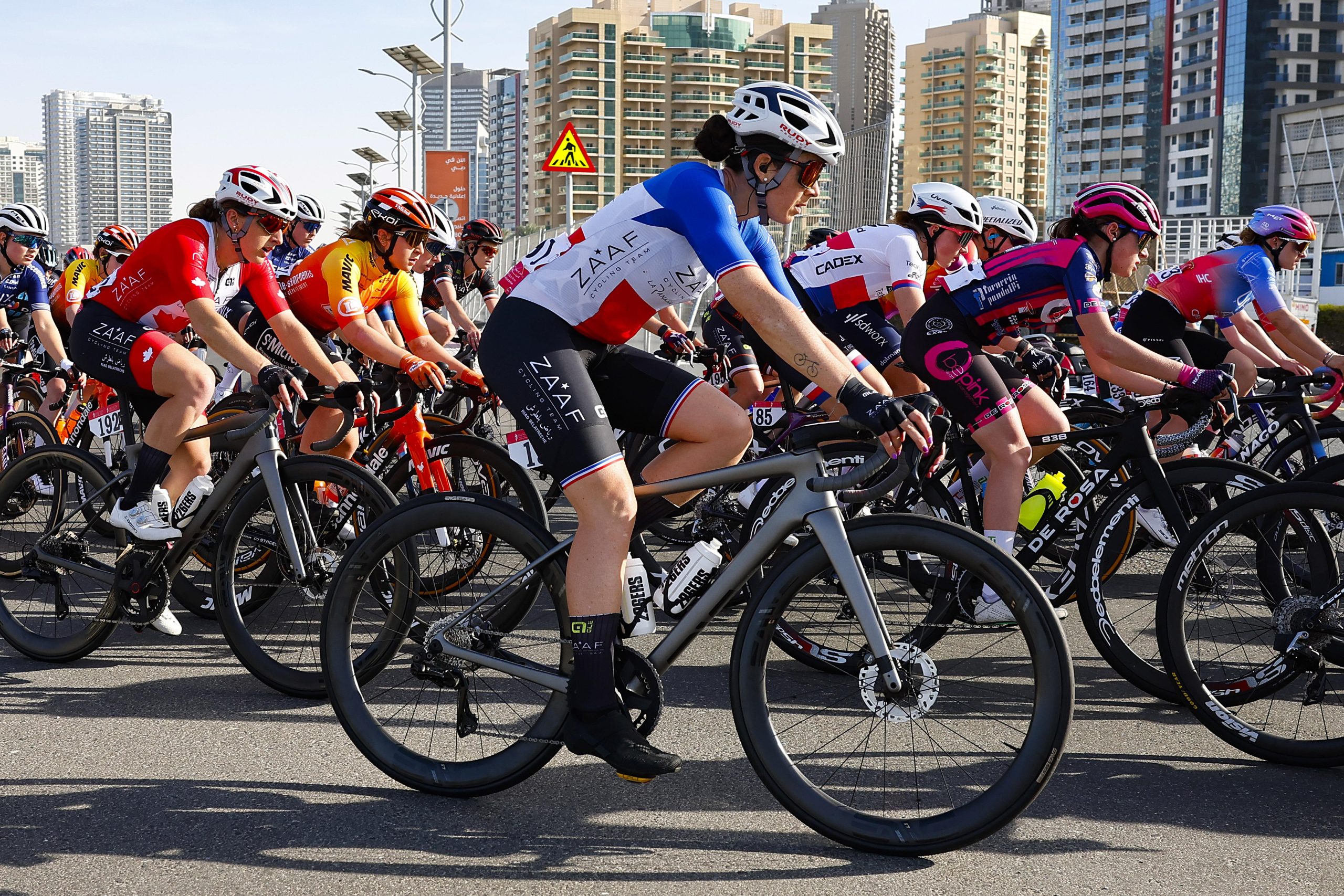
Neither Riad nor Sheima Belatreche responded to several e-mailed requests for comment for this story, including a detailed list of questions. But the team has been far more proactive about policing rider behavior. After several riders contacted The Cyclists’ Alliance to register complaints about pay issues and begin the process to call on the team’s bank guarantee, they were sidelined from races in what they believe was retaliation. Another rider was told via repeated calls and text messages that her behavior – including talking to TCA – was inappropriate and making things complicated, and that Riad Belatreche was angry with her, which she read as an attempt to silence her through intimidation.
All of this would be bad enough on its own. But perhaps the most aggravating part of the whole episode is that it’s a re-run.
A bad sequel
Riad Belatreche first explored starting a women’s cycling team in 2020, and finally did in 2022, according to two people involved with the previous iteration of the team. Belatreche wanted a Continental license, but was unable to provide the required documentation, so he settled for a club-level team that year. (Lacambra was not involved at that time.)
As with this year’s team, the 2022 Zaaf squad started out with high hopes and promises to the 11 riders from seven nations who made up the team, only to soon fall apart. The parallels are clear: both sources told me that, from the start, salaries went either unpaid or only partially paid, depending on the individual. Some staff quit the team in frustration after just a few months. “They were impossible to work with in an orderly manner,” one source said of the Belatreche family, adding that Riad seemed mostly interested in talking about power and money.
Riders and staff were sometimes abruptly fired via text message or simply cut off from groups on WhatsApp without explanation, and the team’s last UCI race was the Navarra Women’s Elite Classics on May 11. “Working with them was the worst personal experience I’ve had in my life,” said another source. “They promised a lot of things, but they don’t care about the cyclists.”
But few people knew about the 2022 team’s problems, and the two team insiders I spoke with said they weren’t aware of anyone approaching governing bodies or TCA for help. “It’s a bit frustrating, but unless a rider comes to us, it’s really hard to help them,” said TCA Executive Director Iris Slappendel. She noted that the troubles on the 2023 edition of the team attracted more attention “because some high-profile riders were brave enough to step up and take action. In most teams, riders just hope for the best.”
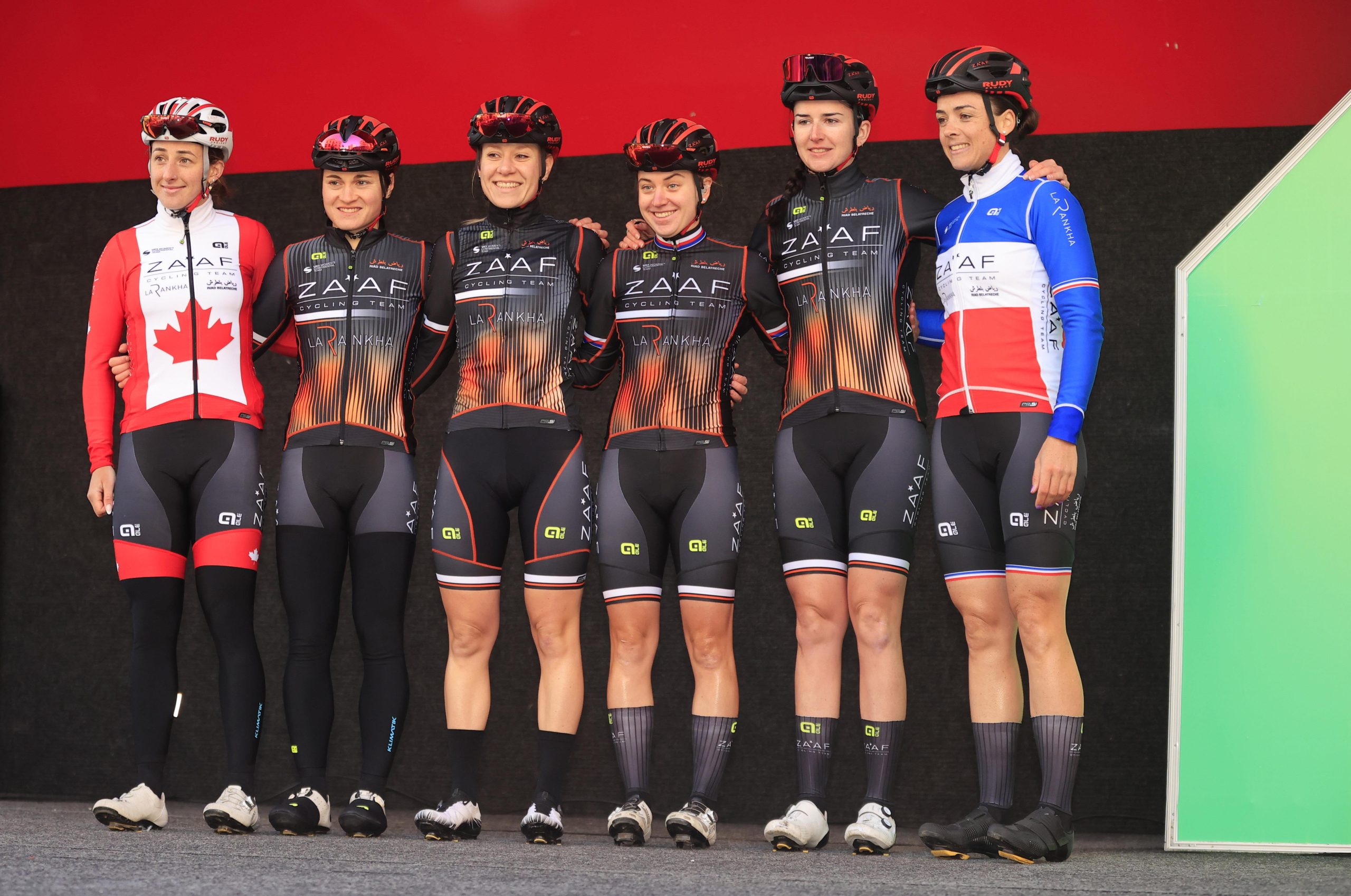
There are two primary levers that governing bodies can pull when riders go unpaid: they can start the process of accessing the bank guarantee, an escrow account of sorts that all UCI-licensed teams are required to have; and they can give riders an early exit from their contracts, which normally is not allowed until June 1.
Jeff Reymond has only been director at TCA since February, but he’s worked in athlete representation and unions most of his career. He’s still learning the quirks of the sport, but said so far, “the UCI has been great. I pick up my phone and I call [my contact], we speak for half an hour, we try to find a solution.” The UCI was responsive and “quite understanding” of complaints about Zaaf. (Riders agreed, saying both organizations had been “amazing” to work with.)
But, Reymond continued, “any problems for a Continental team, I have to go to the national federation, so the contact person isn’t really the UCI.” Continental teams are managed by national federations; in Zaaf’s case the Real Federación Española Ciclismo (RFEC). What is happening in response to rider complaints is not fully clear; when we spoke in mid-April, Reymond said the UCI was still waiting on some documents it had requested three weeks prior.
Reymond and several riders said they were told the RFEC was working with the UCI, but while riders have had updates from TCA and the UCI, no rider I spoke with has received direct communications from the RFEC. Some suspect it is slow-walking the case. The federation did not respond to my request for comment.
For its part, the UCI declined an interview request, instead providing a short statement acknowledging it was aware of “alleged issues” at Zaaf and that “the UCI is in the process of clarifying the situation with the riders, the team, and the national federation responsible for the team registration” and that it would consider rider requests for contract termination.
The UCI appears to be moving quickly on that front, as last week’s rush of exits shows. After Cordon-Ragot’s move to Human Powered Health, Lizzie Stannard found a ride at Israel-Premier Tech Roland, while Lucie Journier announced on April 20 that she had signed with Coop-Hitec. The same day, Mareille Meijering’s signing with Movistar was announced.
But Maggie Coles-Lyster, Michaela Drummond, and Heidi Franz are still actively looking for homes (Coles-Lyster and Drummond will both race track this season as well). April is a desperate time to try to find a new team, and it’s unlikely that everyone who wants to leave will find a spot this year. Not even all the B&B-linked riders found new teams in December, and with team budgets largely committed for the season, there are fewer openings now.
The bank guarantee is a far lengthier process; UCI rules allow the team to dispute the riders’ claims, and even if the riders prevail, the funds can’t be accessed for at least a month after that. In mid-April, riders told me, Zaaf reportedly made partial payments to a few riders still on the team, which may halt or stall the process of drawing on the bank guarantee.
In any case, as TCA’s Reymond pointed out, the required bank guarantee for Continental teams is only €20,000 or 15% of total rider and staff salaries, whichever is higher. In a case with multiple claimants like Zaaf, where as many as nine of the team’s original 15 riders had filed claims as of mid-April, it’s unlikely anyone will ever see the full amount owed to them.
How to stop a repeat
Just as 2023 Zaaf wasn’t the first Zaaf to collapse, it’s also far from the only team to encounter similar difficulties.
After all, Zaaf was able to sign high-profile riders in part because of the sudden demise of B&B Hotels. Raúl Banqueri, a data journalist with Lanterne Rouge who had noted Zaaf’s 2022 troubles and started investigating the new team as early as December, told me that Zaaf reminded him of another recent debacle he covered, Casa Dorado, with similarly grandiose promises and a mysterious sponsor that didn’t clearly exist. “It was weird because they wanted to operate on €4 million and they don’t have a person working in communications,” he said of Zaaf. Instead, he got social media messages from someone he believes is Riad Belatreche’s wife, demanding to know who he was. “It was like a way to intimidate me,” he said.
The business of pro cycling seems to attract both dreamers and grifters, and it’s sometimes difficult to tell them apart. But those in the sport can be too credulous at times. Witness the NextHash debacle that helped sink the Qhubeka team in 2021. Or the odd saga, the year before, of GreenEdge Cycling (currently known as Jayco-AlUla), which agreed to, and then abruptly canceled, a deal to sell the WorldTour team to an obscure Spanish entity called Manuela Fundacion, which then ran its own Continental team in 2022 and failed to pay riders for much of the year.
Most famously, almost 20 years ago then-team manager Giancarlo Ferretti got catfished into believing he was replacing Fassa Bortolo as his team’s title sponsor with multinational wireless firm Sony-Ericsson, only to find out he was the victim of a scammer impersonating a representative of the company, which led to the team’s sudden offseason collapse.
Even when the players are experienced and the intentions sincere there are risks, because the business model of the sport, which makes teams entirely reliant on marketing sponsorships for the overwhelming majority of their budgets, encourages what TCA’s Slappendel calls a game of poker. “You have teams saying to riders, ‘We have this amazing plan, we have the sponsors, 99% sure’,” she said. “And then they go to the sponsors and say, ‘We have these amazing riders, we’re 99% sure they’re going to sign.’” Team officials play one to get the other, but if the sponsor pulls out at the last minute, the riders who signed now-worthless contracts are the ones left holding the worst hand.
But Lacambra aside, Zaaf wasn’t run by experienced people, and had already been in serious trouble. So why didn’t anyone see the likelihood of more issues?
There are very few ways for riders to get concrete insight into a team’s financial workings. Even when they do ask, the true answers can be hard to find. One rider told me her agent inquired with the Spanish federation and was told it was a serious project.
And for the B&B victims, at that point in the season there were few other options; delay a decision too long, ask too many questions, and the opportunity could disappear. When the B&B project collapsed, “it was sort of like when the rug is pulled out from underneath you,” said one rider. “You’re kind of grabbing for something to hold onto, and this was something that seemed like a really good handhold.”
That internal pressure to achieve the dream is common, said Slappendel. “Riders really just want to be part of a UCI team to be able to race an international program. They want to believe it’s a good team, that it will do what it promises, in program and equipment and salary.” Continental-level riders, especially young ones who have never been on a UCI team, “are often in a more vulnerable position than riders who have the option to sign for a WorldTour team.”
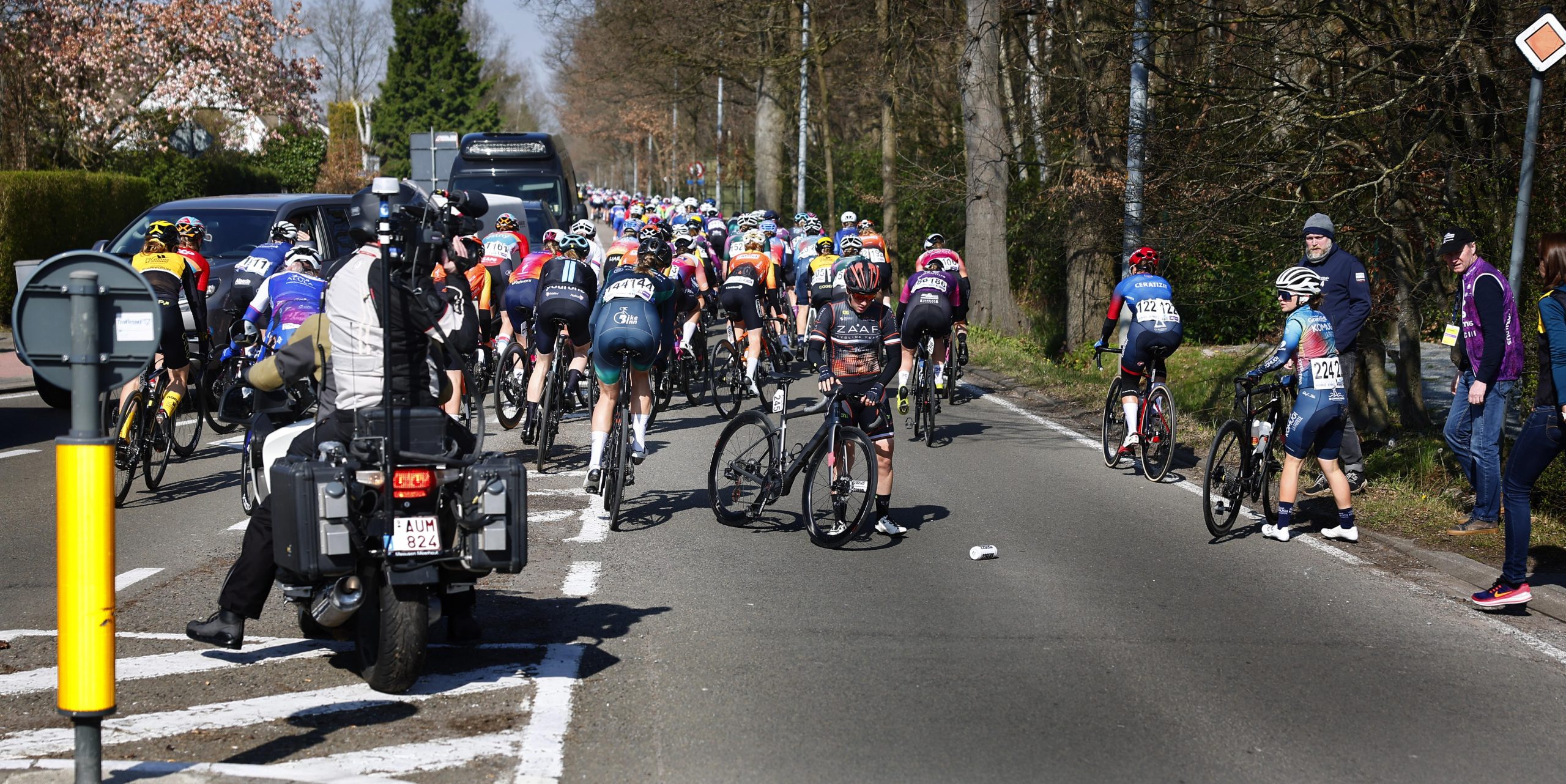
The UCI may not have seen the potential for problems at Zaaf because it largely relies on national federations to vet the operations and finances of Continental teams. The UCI sets the license rules, which do have some teeth: Continental teams must provide a list of team management, copies of contracts with all riders and staff, a sponsor contract or documentary evidence of team income, a budget sheet, proof of insurance, and a copy of the bank guarantee deposit.
But there are 179 men’s Continental teams and 60 women’s, far more than the UCI could ever audit in a short offseason, so it leans heavily on national federations for oversight, and the level of scrutiny may vary. And riders aren’t the only ones prone to a little magical thinking. Even though both Zaaf and B&B Hotels seemed “a little too good to be true,” said Slappendel, “everyone in cycling, including the UCI and federations, hopes that a project like that comes through.”
As for TCA, as Slappendel pointed out, it’s difficult for the organization to act unless riders ask for help. With only a handful of full-time employees, it’s not large enough to proactively police the sport and, in any case, is technically not the UCI-recognized rider union for women’s pro cycling, although the UCI worked well with it in this case.
So what would stop future Zaafs? There are certainly changes that would help. The UCI and national federations can be stricter in how they vet team operations, in particular requiring more financial disclosure in situations where a team owner and sponsor are the same entity.
Slappendel said a middle, or ProTeam, license tier for women’s teams – like on the men’s side of the sport – might take some of the pressure off the Continental ranks. That tier, which could debut in 2026, would create a space for teams like Parkhotel Valkenberg that aren’t at the WorldTour level but have more stability, resources, and professional operations than Continental teams and are better homes for established pros.
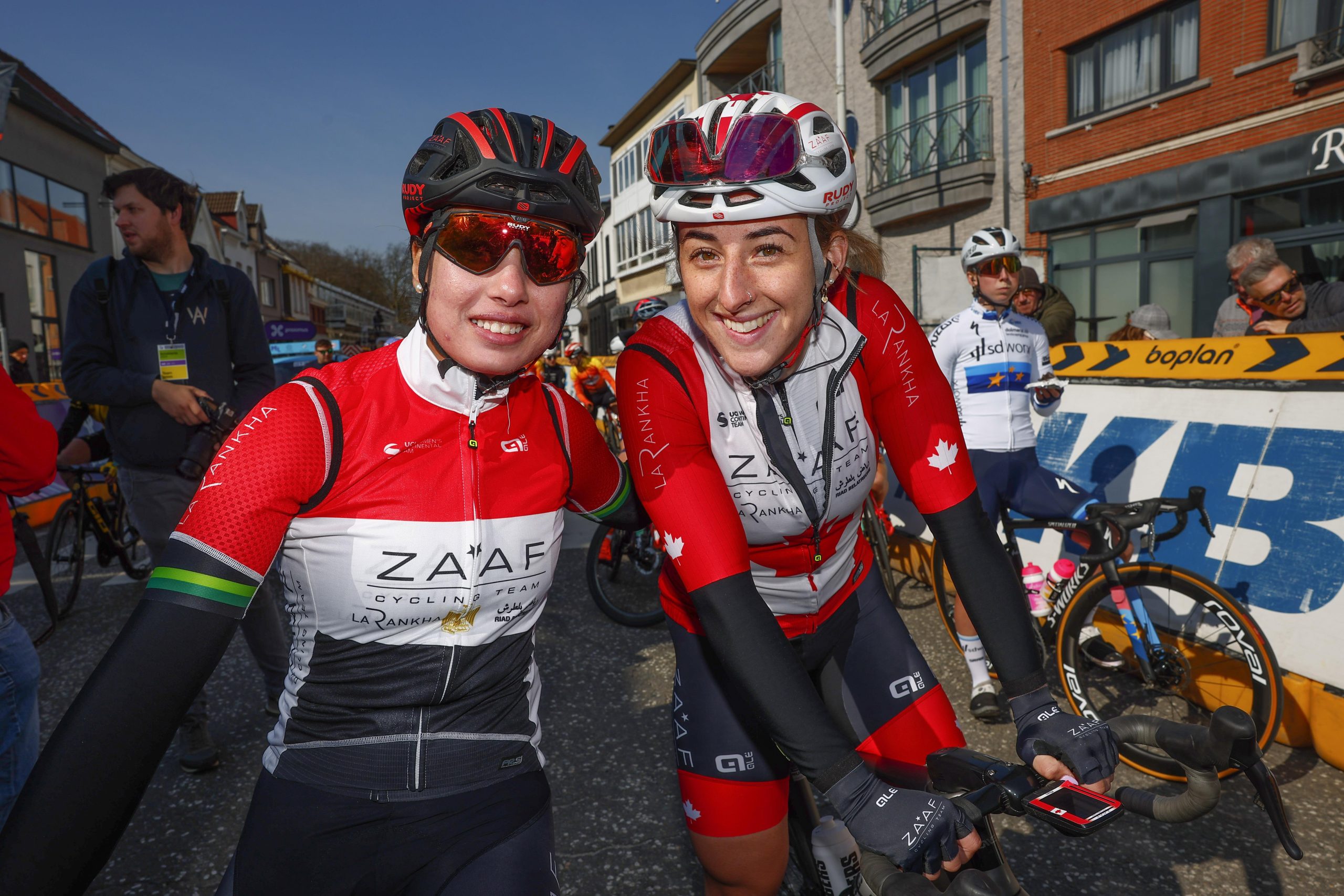
That, in turn, could refocus Continental teams to better serve their primary purpose: rider development. “It’s not salary that’s most important for riders on Continental teams,” Slappendel said. “It’s more about the structure, having a safe environment, a race program, the base to develop yourself. But Slappendel noted that, right now, rider salary is one of the few concrete tools federations have to assess those structures.
And more rider education is essential, both about what to ask prospective employers, and to know their rights when contractually obligated terms aren’t fulfilled. Slappendel says this is a core task for TCA. Again, the whole reason we know what’s going on at Zaaf is a group of riders who not only recognized clear mistreatment, but refused to tolerate it.
There aren’t really silver linings to be found, but the riders I spoke with spontaneously voiced their gratitude for each other’s support. “The one good thing was the solidarity with each other,” said one. “It just brought us all together, and we will always stay close because of this shit.” Another hoped the episode might offer some much-needed accountability and further professionalize the sport. “No one should experience this kind of mistreatment,” she said. “We’re just trying to do our jobs as best as possible.”
But absent all of those fixes, and more systemic ones, Zaaf likely won’t be the last sad, preventable tale in the sport.
The Zaaf legacy
Abdel Kader Zaaf, Riad Belatreche’s grandfather and namesake of the team, was famous for more than simply being a pioneering rider of color in a (still) overwhelmingly white sport. Stage 13 of the 1950 edition of the Tour de France, his third attempt, was more than 200 km long, with temperatures approaching 40 ºC (100 ºF). Undeterred, Zaaf forged an early two-rider breakaway with teammate Marcel Molinès that gained more than 20 minutes on a thoroughly uninterested chase. Since Zaaf was fifth overall, that was enough to put him in yellow if it held.
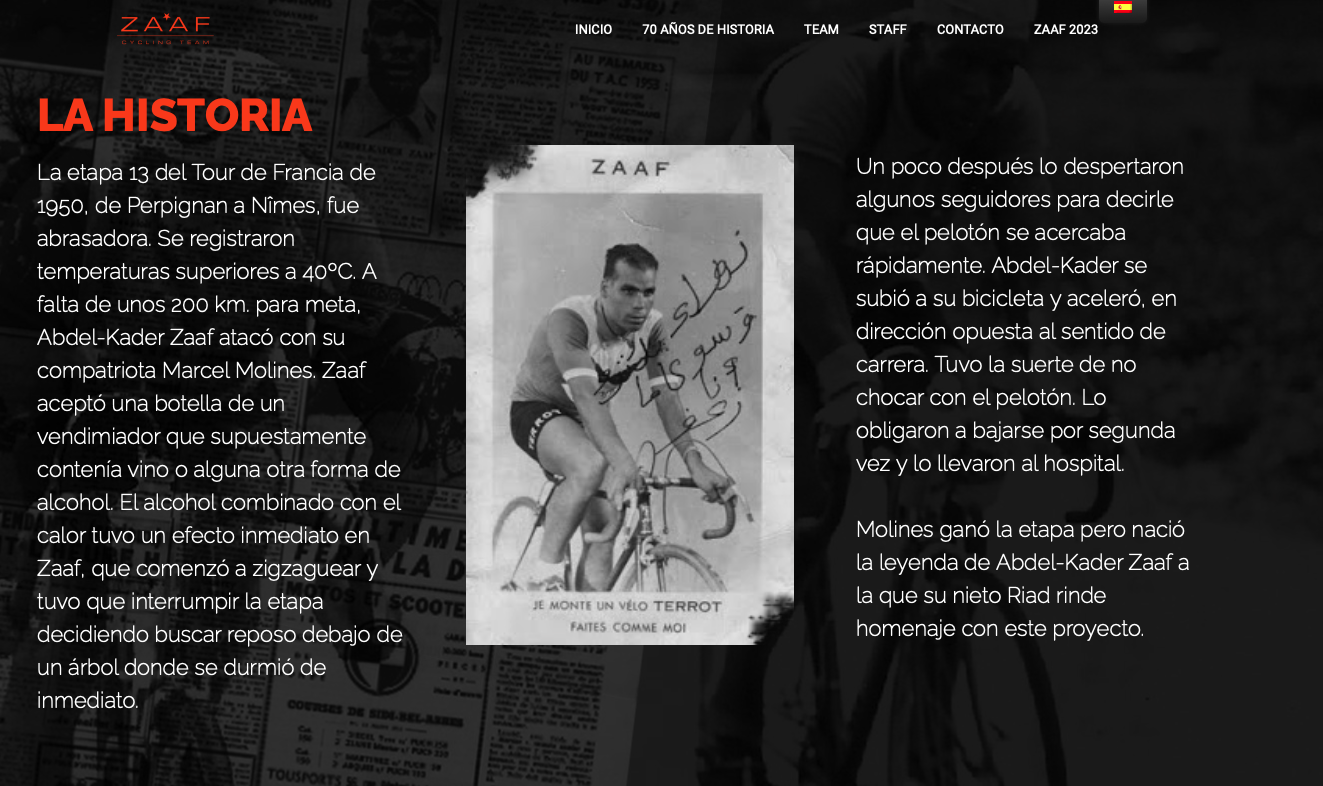
But as Svend Novrup recounts in his book “A moustache, poison and blue glasses: Tales from the Tour de France,” just 20 km from the finish, suffering from the sweltering heat, Zaaf took a bottle from a roadside fan and drank heavily. “The bottle was white wine,” writes Novrup. “Zaaf, a Muslim, had never drunk alcohol.”
The wicked combination of heat, dehydration, and booze essentially knocked him out, asleep under a tree. While Molinès continued to the stage win, Zaaf gradually awoke and remounted his bike; disoriented, he set off the wrong way, backward on the course, before he was stopped by spectators and put in an ambulance. Instead of an historic stage win or yellow jersey, he was out of the race.
There is no shame in the tale. It features prominently in the team’s own website and social media, and the episode made him a minor celebrity; in Novrup’s telling, Zaaf made a small fortune on the post-Tour criterium scene that year. But it’s a stark image of progress reversed, especially in contrast to how far women’s cycling has come in the past decade.
Riad Belatreche is rightly proud of his ancestor’s trailblazing accomplishments. The question is whether, by his actions, he is actually honoring them, or if he’s taking the sport the wrong way.
Did you find this investigation worthwhile? Please consider helping make them happen by becoming a member. Escape Collective is member-funded, which offers us the independence and ability to pursue important stories and tell them with the depth and care they deserve.
Did we do a good job with this story?

